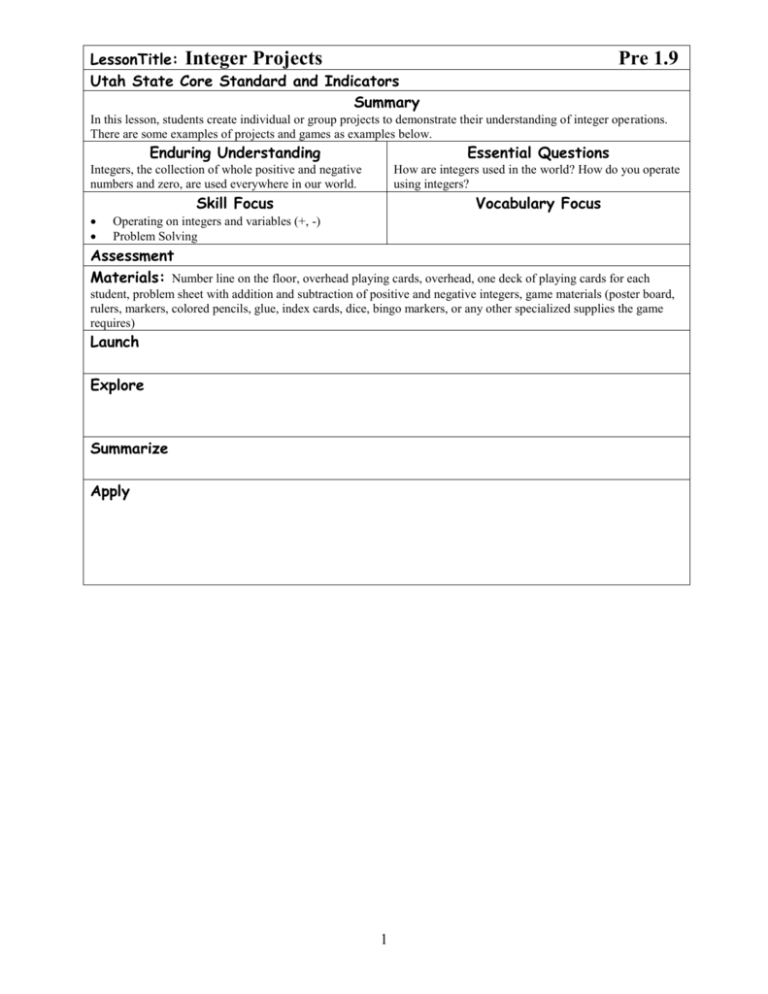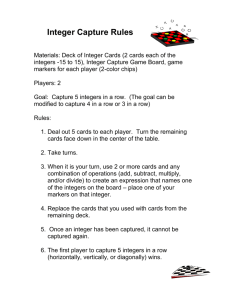Pre 1.9 Integer Project 1
advertisement

LessonTitle: Integer Projects Utah State Core Standard and Indicators Summary Pre 1.9 In this lesson, students create individual or group projects to demonstrate their understanding of integer operations. There are some examples of projects and games as examples below. Enduring Understanding Essential Questions Integers, the collection of whole positive and negative numbers and zero, are used everywhere in our world. How are integers used in the world? How do you operate using integers? Skill Focus Vocabulary Focus Operating on integers and variables (+, -) Problem Solving Assessment Materials: Number line on the floor, overhead playing cards, overhead, one deck of playing cards for each student, problem sheet with addition and subtraction of positive and negative integers, game materials (poster board, rulers, markers, colored pencils, glue, index cards, dice, bingo markers, or any other specialized supplies the game requires) Launch Explore Summarize Apply 1 Pre 1.9 Integer Project 1 Integer Rules in Context Student groups will create multimedia presentations involving a power point presentation, posters, videos etc. Integer rules in context (see below) Part I. Write all the possible combinations of adding and subtracting using positive or negative 5 and positive or negative 7. __________ __________ __________ __________ __________ __________ __________ __________ __________ __________ __________ __________ Eliminate all duplications. Write what is left below. __________ __________ __________ __________ __________ __________ Demonstrate the rules for the remaining problems above using a real life context such as mountain climbing & deep sea diving, money, temperature, etc. Part II. Write all the possible combinations of multiplying and dividing you can think of using positive or negative 3 times 4. This of course would also involve division using positive or negative 12. __________ __________ __________ __________ __________ __________ __________ __________ __________ __________ __________ __________ Eliminate all duplications. Write what is left below. __________ __________ __________ __________ __________ __________ Demonstrate the rules for the remaining problems above using a real life context such as mountain climbing & deep sea diving, money, temperature, etc. Part III. Present examples of how integers are used in the world. Part of this might be creating a scenario of a world without integers. 2 Pre 1.9 Integer Project 2 Game Time Materials: cardboard, markers, number cubes, spinners, or index cards 1. Work with a partner. Brainstorm ideas for a new board game. The board itself must include a starting point and a finish point and squares in between. The theme for the game can be anything you find interesting. (Possibilities include intergalactic travel, a mysterious labyrinth, a treasure hunt, or a bicycle race. (20 points) 2. Decide how players will move their game pieces along the board. You may use two number cubes, two spinners, or integers written on index cards to indicate the distance a game piece will be moved. Use positive and negative integers. (10 points) 3. Include a square on which you have written “negative one” (-1). Whenever a player lands on this square, he or she must multiply the number of squares he or she just moved by –1 and move again. You need to be able to explain what happens to the move because of this square. (5 points) 4. Create several different game pieces or collect game pieces from existing games. (10 points) 5. Write a complete set of directions for your game. Play the game once to see if it has any “bugs” that you want to fix. Have the person you play this game with, sign your directions sheet. (5 points) This project is due on ______________ . We will be playing these games in class on Friday. The total project is worth 50 points. 10 points Extra Credit: _____________________________________ Parent/Guardian Signature 3 Integer “War” (Addition) Use a regular deck of playing cards. An ace = 1, a Jack = 11, a queen = 12, a king = 0. Assign black cards as positive and red cards as negative. Players divide a deck of cards evenly among themselves. They each turn over two cards and add them. The player with the greatest sum collects all of the cards. If there is a tie, each player deals out three cards face down. Then each player turns two cards face up. The player with the greatest sum collects all of the cards. When one player has all of the cards, he/she is the winner. 4 Integer Football 1 colored die (the numbers on the face of the colored die are negative) 2 white dice (the numbers on the faces of the white die are positive) See gameboard below. Divide the class into two teams. The student turn consists of the following: The team starts at the “50 yard line.” The student will roll all three dice three times. Write the results of the rolls on the board (-5 + 12 + 4= ___). The student then must answer the problem. If they are right the team gets a point. If the total is more than ten then the team gets a “first down” and it is the next players turn. If the total is less than ten, then the student can “go for it” and roll all three dice one more time to try and get the total to over ten. If the total is more than ten it is a “first down” and the next player gets to go. If it is not more than ten, it is a “turnover” and the other team gets the ball at that spot. If they can’t get a first down, they can “punt” and the other team gets the ball at the “50 yard line.” If they are wrong it is a “turnover” and the other team gets the ball at that spot. If they don’t know the answer, they can “call time out” and ask one person from their team for help. Each team only gets two “time outs” per game. If the total is more than twenty, they can move twenty yards. If on their turn they get to the “end zone” it is a “touchdown.” The team gets seven points and it is the other teams ball at the 50 yard line.” If anybody blurts out an answer, it is “penalty” which results in a “turnover.” To keep all students involved, I have them write each problem down ad solve it. This is how they get their credit for the day. They all end up with about 40-50 integer addition problems. 5 50 40 30 20 10 TOUCHDOWN 6 7








